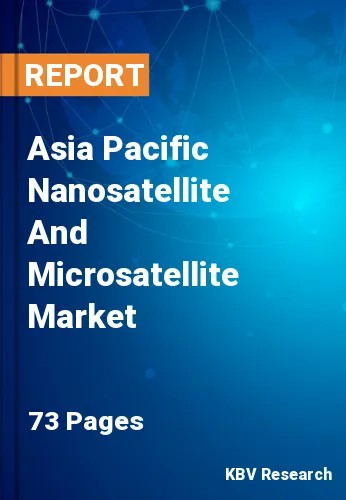The Asia Pacific Nanosatellite And Microsatellite Market would witness market growth of 23.6% CAGR during the forecast period (2022-2028).
The creation of Small Satellite Launch Vehicles (SSLVs) is the result of the increased requirement for compact launch vehicles, which can overcome these financial limitations. Additionally, reduced entry barriers and institutional and private investment are enabling manufacturers to rapidly create SSLVs and seize a potential market share for nanosatellites.
Nanosatellites and microsatellites are less costly than standard satellites. Because of their quicker development cycles, lightweight properties, high potential for executing complicated computer operations, and decreased launch costs, there is a growth in the demand for these types of satellites. Launching clusters of nano- and microsatellites allow companies to deliver a wide variety of satellite-based services.
Microsatellites and nanosatellites help conserve a substantial amount of resources. This helps in the reduction of barriers to reaching and exploring space, which has resulted in a spike in the adoption of small satellites. The most significant benefit that small satellites offer is the short duration of time it requires to create them. While it can take anywhere from five to fifteen years to create a typical or big satellite and put it into orbit, a nanosatellite might be developed and deployed into the correct orbit in fewer than eight months.
The Asia Pacific Space Cooperation Organization is China's most significant multilateral cooperation endeavor (APSCO). China, Bangladesh, Pakistan, Peru, Thailand, Indonesia, Iran, Mongolia, and Turkey are its nine constituent nations. The mission of APSCO is to advance multilateral collaboration among its member nations in the fields of space science, applications, and technology. Seven international R&D initiatives are now in progress at APSCO.
The China market dominated the Asia Pacific Nanosatellite And Microsatellite Market by Country in 2021, and would continue to be a dominant market till 2028; thereby, achieving a market value of $540.1 million by 2028.The Japan market is estimated to grow a CAGR of 22.8% during (2022 - 2028). Additionally, The India market would experience a CAGR of 24.3% during (2022 - 2028).
Based on End-Use, the market is segmented into Commercial, Government, Defense & Security and Civil. Based on Application, the market is segmented into Earth Observation/Remote Sensing, Communication & Navigation, Scientific Research and Technology & Academic Training. Based on Mass, the market is segmented into Nanosatellites and Microsatellites. Based on countries, the market is segmented into China, Japan, India, South Korea, Singapore, Malaysia, and Rest of Asia Pacific.
Free Valuable Insights: The Worldwide Nanosatellite And Microsatellite Market is Projected to reach USD 8 Billion by 2028, at a CAGR of 22.3%
The market research report covers the analysis of key stake holders of the market. Key companies profiled in the report include Dauria Aerospace, GomSpace Group AB, ISISPACE Group, Sierra Nevada Corporation (SNC), Spire Global, Inc., AAC Clyde Space, Surrey Satellite Technology Limited (SSTL), The Boeing Company, and Tyvak International
By End-Use
By Application
By Mass
By Country
Our team of dedicated experts can provide you with attractive expansion opportunities for your business.

